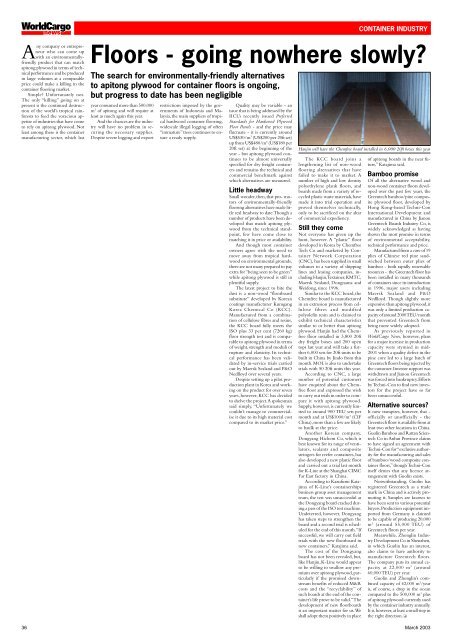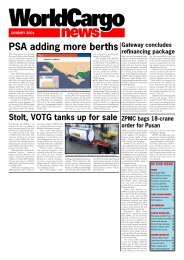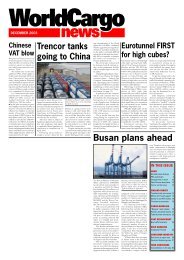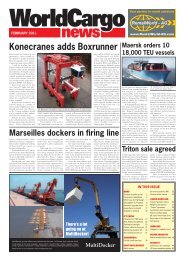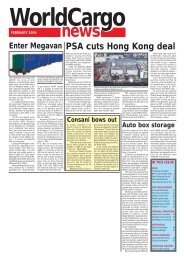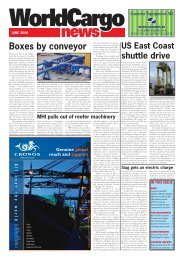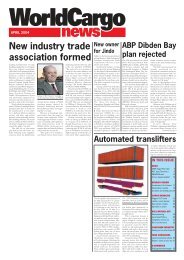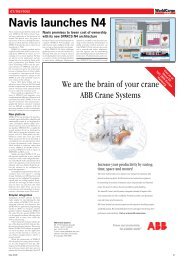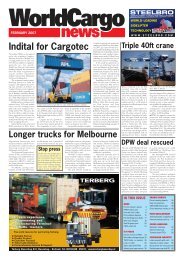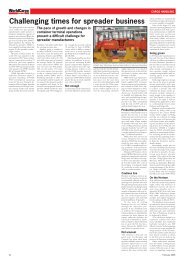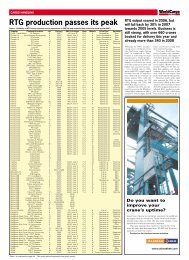March Front Cover - WorldCargo News Online
March Front Cover - WorldCargo News Online
March Front Cover - WorldCargo News Online
Create successful ePaper yourself
Turn your PDF publications into a flip-book with our unique Google optimized e-Paper software.
<strong>WorldCargo</strong>newsAny company or entrepreneurwho can come upwith an environmentallyfriendlyproduct that can matchapitong plywood in terms of technicalperformance and be producedin large volumes at a comparableprice could make a killing in thecontainer flooring market.Simple? Unfortunately not.The only “killing” going on atpresent is the continued destructionof the world’s tropical rainforeststo feed the voracious appetiteof industries that have cometo rely on apitong plywood. Notleast among these is the containermanufacturing sector, which last36CONTAINER INDUSTRYFloors - going nowhere slowly?The search for environmentally-friendly alternativesto apitong plywood for container floors is ongoing,but progress to date has been negligibleyear consumed more than 500,000m 3 of apitong and will require atleast as much again this year.And the chances are the industrywill have no problem in securingthe necessary supplies.Despite severe logging and exportrestrictions imposed by the governmentsof Indonesia and Malaysia,the main suppliers of tropicalhardwood container flooring,widescale illegal logging of often“immature” trees continues to ensurea ready supply.Quality may be variable - anissue that is being addressed by theIICL’s recently issued PreferredStandards for Hardwood PlywoodFloor Panels - and the price mayfluctuate - it is currently aroundUS$530/m 3 (US$200 per 20ft set)up from US$480/m 3 (US$180 per20ft set) at the beginning of theyear - but apitong plywood continuesto be almost universallyspecified for dry freight containersand remains the technical andcommercial benchmark againstwhich alternatives are measured.Little headwaySmall wonder, then, that pro- motorsof environmentally-friendlyflooring alternatives have made littlereal headway to date. Though anumber of products have been developedthat match apitong plywoodfrom the technical standpoint,few have come close tomatching it in price or availability.And though most containerowners agree with the need tomove away from tropical hardwoodon environmental grounds,there are not many prepared to payextra for “being seen to be green”while apitong plywood is still inplentiful supply.The latest project to bite thedust is a non-wood “floorboardsubstitute” developed by Koreancoatings manufacturer KumgangKorea Chemical Co (KCC).Manufactured from a combinationof cellulose fibres and resins,the KCC board fully meets theISO plus 33 per cent (7260 kg)floor strength test and is comparableto apitong plywood in termsof weight, strength and moduli ofrupture and elasticity. Its technicalperformance has been validatedby in-service trials carriedout by Maersk Sealand and P&ONedlloyd over several years.Despite setting up a pilot productionplant in Korea and workingon the product for over sevenyears, however, KCC has decidedto shelve the project. A spokesmansaid simply, “Unfortunately wecouldn’t manage to commercialiseit due to its high material costcompared to its market price.”Hanjin will have the Chemfree board installed in 6,000 20ft boxes this yearThe KCC board joins alengthening list of non-woodflooring alternatives that havefailed to make it to market. Anumber of high and low densitypolyethylene plank floors, andboards made from a variety of recycledplastic waste materials, havemade it into trial operation andproved themselves technically,only to be sacrificed on the altarof commercial expediency.Still they comeNot everyone has given up thehunt, however. A “plastic” floordeveloped in Korea by ChemfreeTech Co and marketed by ContainerNetwork Corporation(CNC), has been supplied in smallvolumes to a variety of shippinglines and leasing companies, includingHanjin, Textainer, KMTC,Maersk Sealand, Dongnama andWeidong, since 1996.Similar to the KCC board, theChemfree board is manufacturedin an extrusion process from cellulosefibres and modifiedpolyolefin resin and is claimed toexhibit technical characteristicssimilar to or better than apitongplywood. Hanjin had the Chemfreefloor installed in 3,800 20ftdry freight boxes and 200 opentops last year and will take a further6,000 sets for 20ft units to bebuilt in China by Jindo from thismonth. MOL is also to undertaketrials with 50 20ft units this year.According to CNC, a largenumber of potential customershave enquired about the Chemfreefloor and expressed the wishto carry out trials in order to compareit with apitong plywood.Supply, however, is currently limitedto around 900 TEU sets permonth and at US$1000/m 3 (CIFChina), more than a few are likelyto baulk at the price.Another Korean company,Dongyang Hichem Co, which isbest known for its range of ventilators,sealants and compositestringers for reefer containers, hasalso developed a new plastic floorand carried out a trial last monthfor K-Line at the Shanghai CIMCFar East factory in China.According to Kazufumi Katajimaof K-Line’s containershipsbusiness group asset managementteam, the test was unsuccessful asthe Dongyang board cracked duringa pass of the ISO test machine.Undeterred, however, Dongyanghas taken steps to strengthen theboard and a second trial is scheduledfor the end of this month. “Ifsuccessful, we will carry out fieldtrials with the new floorboard innew containers,” Katajima said.The cost of the Dongyangboard has not been revealed, but,like Hanjin, K-Line would appearto be willing to swallow any premiumover apitong plywood, particularlyif the promised downstreambenefits of reduced M&Rcosts and the “recyclability” ofsuch boards at the end of the container’slife prove to be valid. “Thedevelopment of new floorboardsis an important matter for us. Weshall adopt them positively in placeof apitong boards in the near future,”Katajima said.Bamboo promiseOf all the alternative wood andnon-wood container floors developedover the past few years, theGreentech bamboo/pine compositeplywood floor, developed byHong Kong-based Techni-ConInternational Development andmanufactured in China by JianouGreentech Boards Industry Co, iswidely acknowledged as havingshown the most promise in termsof environmental acceptability,technical performance and price.Manufactured from a core of 19plies of Chinese red pine sandwichedbetween outer plies ofbamboo - both rapidly renewableresources - the Greentech floor hasbeen installed in many thousandsof containers since its introductionin 1996, major users includingMaersk Sealand and P&ONedlloyd. Though slightly moreexpensive than apitong plywood, itwas only a limited production capacityof around 2000 TEU/monththat prevented Greentech frombeing more widely adopted.As previously reported in<strong>WorldCargo</strong> <strong>News</strong>, however, plansfor a major increase in productioncapacity were stymied in mid-2001 when a quality defect in thepine core led to a large batch ofGreentech floors being rejected bythe customer. Investor support waswithdrawn and Jianou Greentechwas forced into bankruptcy. Effortsby Techni-Con to find new investorsfor the project have so farbeen unsuccessful.Alternative sources?It now transpires, however, that -officially or unofficially - theGreentech floor is available from atleast two other locations in China.Guolin Bamboo and Rattan ScientechCo in Anhui Province claimsto have signed an agreement withTechni-Con for “exclusive authorityfor the manufacturing and salesof bamboo/wood composite containerfloors,” though Techni-Conitself denies that any licence arrangementwith Guolin exists.Notwithstanding, Guolin hasregistered Greentech as a trademark in China and is actively promotingit. Samples are known tohave been sent to various potentialbuyers. Production equipment importedfrom Germany is claimedto be capable of producing 20,000m 3 (around 55,000 TEU) ofGreentech floors per year.Meanwhile, Zhonglin IndustryDevelopment Co in Shenzhen,in which Guolin has an interest,also claims to have authority tomanufacture Greentech floors.The company puts its annual capacityat 22,000 m 3 (around60,000 TEU) per year.Guolin and Zhonglin’s combinedcapacity of 42,000 m 3 /yearis, of course, a drop in the oceancompared to the 500,000 m 3 plusof apitong plywood currently usedby the container industry annually.It is, however, at least a small step inthe right direction. ❏<strong>March</strong> 2003


